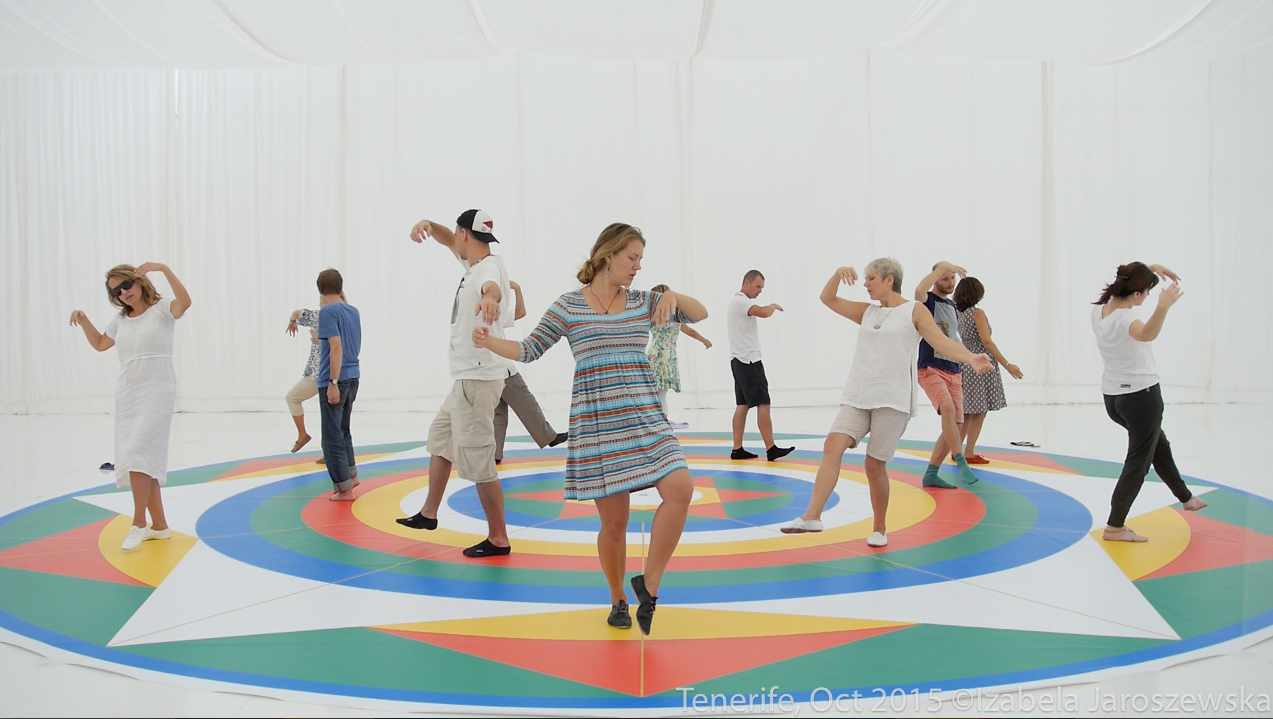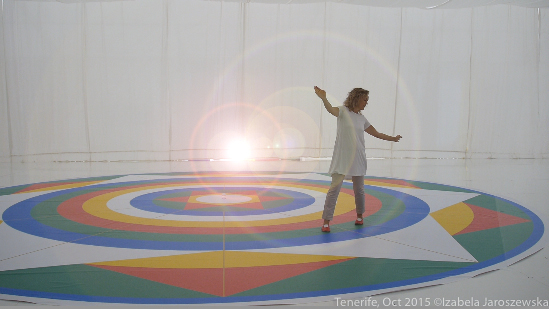Part Two – The Dance of the Vajra
Chögyal Namkhai Norbu, a renowned scholar and widely acknowledged to be one of the greatest living masters of Dzogchen, the essence of Tibetan Buddhism, first introduced this Dance of the Vajra to his students in 1990. It is mainly practised in various places and centres of the Dzogchen Community all around the world.
Vajra is a Sanskrit term that could be translated as “indestructible condition” with its symbolic images like a thunderbolt or diamond. In the Dzogchen teaching the indestructible condition or Vajra means our real nature, the real condition of all phenomena, which is non-dual and beyond judgment and intellectual conceptual thinking.
In the Dzogchen teaching, sound and movement are very important because they are the means to integrate the three aspects of body, energy, and mind into the knowledge of the state of contemplation.
Chögyal Namkhai Norbu said; “Sound is the basis from which energy develops. Sound develops through light and color to a more physical level and then we have movement.”
The Dance of the Vajra is principally a practice to harmonize the energy of the individual.
Chögyal Namkhai Norbu has transmitted three principal dances of the Vajra: the Dance of the Song of the Vajra, the Dance of the Vajra That Benefits Beings, and the Dance of the Three Vajras. All three are practised on a Mandala according to precise instructions for the steps and movements. These sacred dances are inseparably linked with the transmission of the Dzogchen teaching, and the Dance of the Song of the Vajra is reserved for practitioners who have received the transmission. However, the Dance of the Vajra That Benefits Beings and, to a certain extent, the Dance of the Three Vajras, can also be studied and practised by anyone, including those who are not particularly interested in the Dzogchen teaching. Aside from offering countless relative benefits for our body, energy and mind, these dances also create a cause and connection to enter and be on a path leading to the end of suffering.

Twelve practitioners, six females and six males, dance together on a large geometric diagram, the Mandala, representing the correspondence and interdependence between the microcosm and macrocosm, between the internal dimension of the individual and the outer dimension of the world.
The slow, co-ordinated movements are precisely connected to a sacred sound and timing, and as we softly sing and practice awareness together they produce an experience of deep relaxation and consequently a calm state of mind.
In the Dance of the Vajra, sound and not intellectual meaning is the main importance. Accompanied by music, we sing sacred syllables that resonate, harmonise, and purify our chakras and energy points in our body or the microcosm, which is interdependently connected to energy fields in our outer world or globe, the macrocosm.
In the Dance of the Vajra the main realisation is to discover the nature of mind, which is beyond all limits. This experience of discovery releases our tensions, allowing us to let go, give less importance to our emotions and attachments, and enter a state of profound relaxation often also described as bliss.
“But beyond the mind, beyond our thoughts, there is something we call the ‘nature of the mind,’ the mind’s true condition, which is beyond all limits. If it is beyond the mind, though, how can we approach an understanding of it? Let’s take the example of a mirror. When we look into a mirror we see in it the reflected images of any objects that are in front of it; we don’t see the nature of the mirror. But what do we mean by this ‘nature of the mirror’? We mean its capacity to reflect, definable as its clarity, its purity, and its limpidity, which are indispensable conditions for the manifestation of reflections. This ‘nature of the mirror’ is not something visible, and the only way we can conceive of it is through the images reflected in the mirror. In the same way, we only know and have concrete experience of that which is relative to our condition of body, voice, and mind. But this itself is the way to understand their true nature.” Excerpted from Chögyal Namkhai Norbu, Dzogchen: The Self-Perfected State (Ithaca: Snow Lion Publications, 1996), 32
In this Dance of the Vajra we apply three types of mindfulness simultaneously. The breath or voice integrates in the Song, the body in the Dance, and the mind in the state of contemplation, a state beyond conceptual dualistic thinking and concepts.

The Mandala
The space where we dance is represented by the Mandala. Considered a symbol of a pure energetic dimension, it is divided into concentric rings and triangular shapes of five colors, representing the five elements of space, water, earth, fire, and air. It contains a number of symbolic sacred geometric forms: circles or spheres, triangles, a hexagon, and twelve lines, which in their composition function like a map. The Mandala further reflects the resonance between the inner energy points and chakras of the individual and the concentrated energy points on our globe, connecting to a deeper meaning and knowledge. The ancients believed that the experience in connection to sacred geometry creates a resonance to our inner dimension, opening us up to a higher awareness with healing benefits.
The Sound or Mantra
In traditional mindfulness practice one of the main focuses is on the breath. In the Dance of the Vajra, the breath is vocalised with the application of natural sounds, with each syllable representing the pure state of a chakra or energy point. The vocalisation of this “sacred sound” has been used by teachers from ancient times to the present, as a means for spiritual realisation. The function of the syllables applied in these dances is to purify and release obstacles, calm the chatter in the mind, and give us access to creative and healing energy, awakening the self to a higher consciousness beyond the need for visualisation or generating particular mental intentions.
The Movement
In the Dance of the Vajra each syllable or sound is connected to a movement or mudra, a Sanskrit term meaning “symbolic gesture” or “seal.” The mudras are hand positions or gestures that influence the energy flow of the body and can change the spiritual and mental aspects of a person. The slow dance movements alternating between the left and right side of the body balance the hemispheres of the brain and the female and male aspects of the individual.
The six male and six female dancers symbolise the non-duality and inseparability of male and female attributes on the external plane. The choreography of the dance creates an experience of awareness of the harmonic possible reality. The sounds and movements in the Dance of the Vajra symbolise enlightened activity, inseparable from the mostly still dormant but real potential present in every sentient being. When awakened and linked to a profound knowledge of our real condition, this potential evolves into self-liberation, mindfulness, loving kindness, and compassion for oneself and consequently all sentient beings.
Applied to all of our activities in ordinary life, this evolution is born of the mastery of the art of mindfulness. It generates happiness and prosperity for oneself, society, and the world.


Leave A Comment